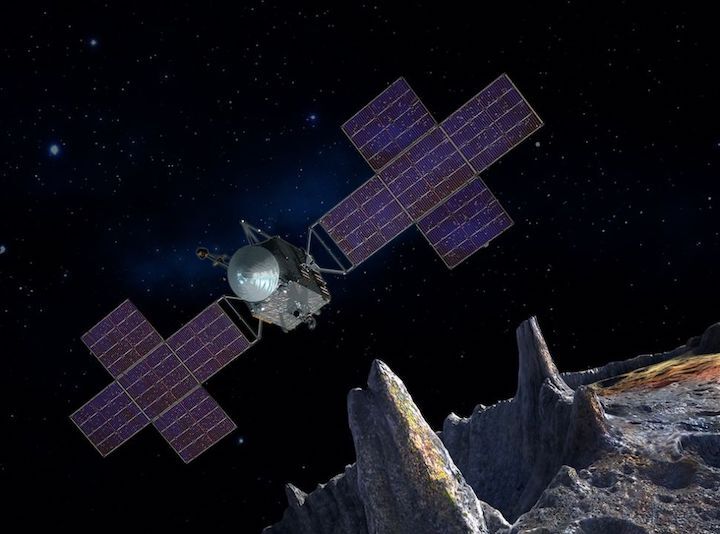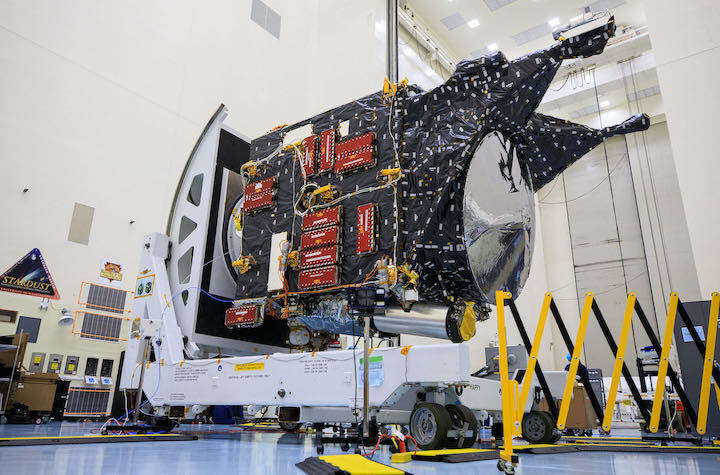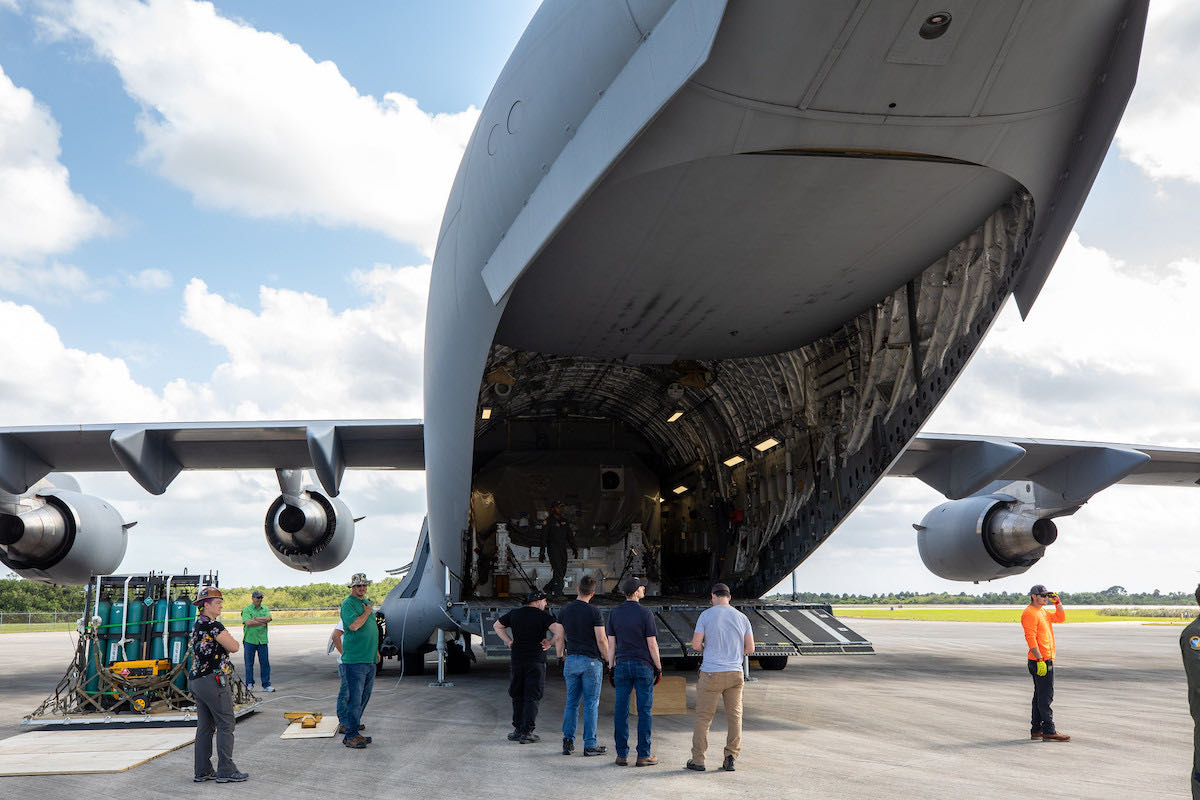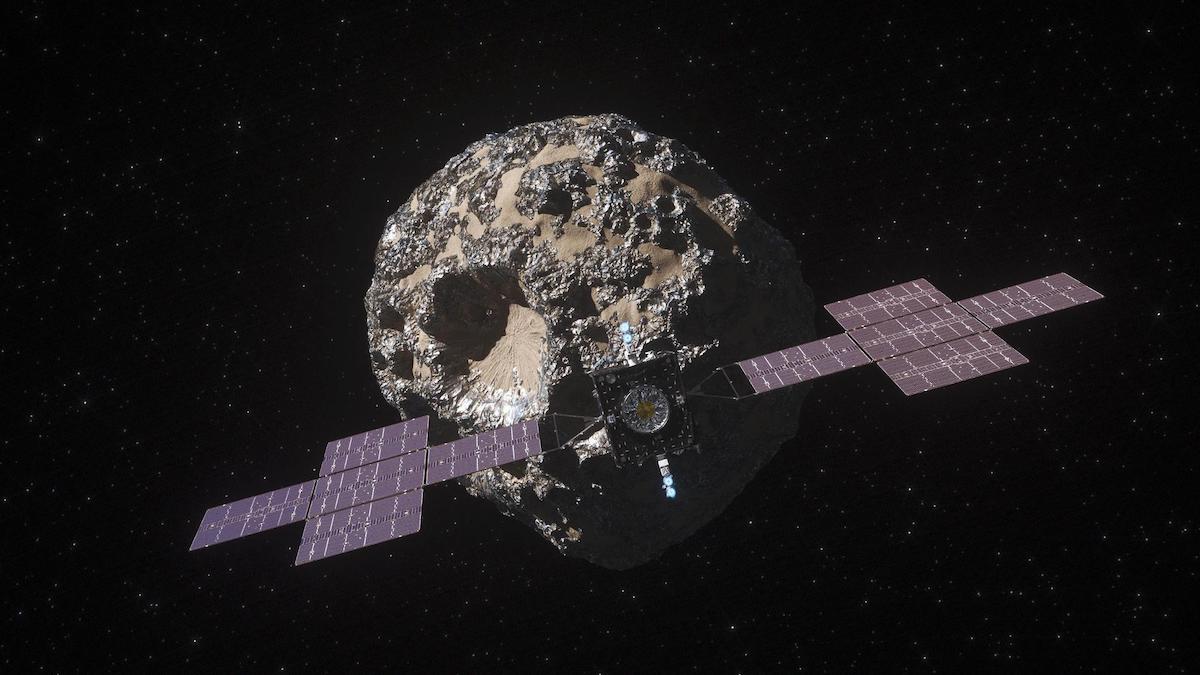6.01.2022
Psyche to begin environmental testing ahead of August 2022 launch
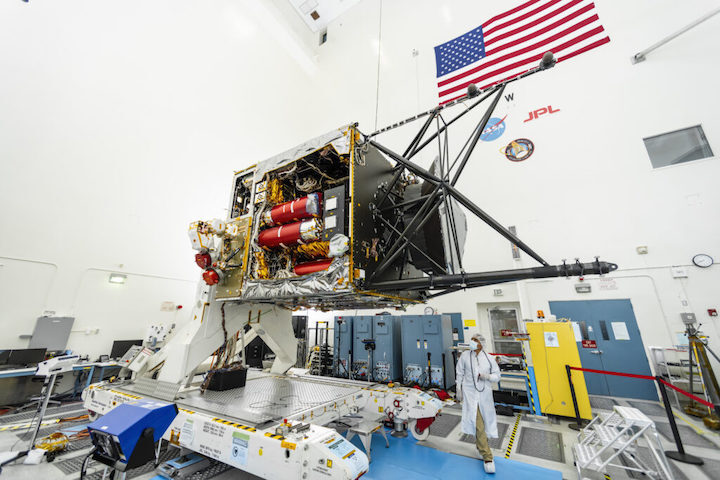
As 2022 begins, the ASU (Arizona State University)-led team for the NASA Psyche spacecraft is preparing to conduct thermal vacuum testing in preparation for launch. Psyche is a first-of-a-kind mission set to orbit an M-Type asteroid, scheduled to launch on a SpaceX Falcon Heavy booster this August.
Following a three-and-a-half-year transit through the inner solar system, Psyche will enter into orbit of the main asteroid belt object, 16 Psyche. Its sister mission, Lucy, is continuing to its first flyby on Earth despite a solar array issue; both missions operate under NASA’s Discovery program.
Psyche overview:
Psyche was selected as a finalist in 2015 to be a part of the Discovery program. In January 2017, it was selected as the 14th mission in the program. At the same time, Lucy was selected for the 13th Discovery mission.
After being selected by NASA, the Psyche team began finalizing the design of the spacecraft and mission. The team finished the preliminary design of the spacecraft in March 2019, and NASA approved the design in May 2019; this allowed the team to begin spacecraft and instrument construction.
The Psyche spacecraft is based around Maxar’s 1300-class spacecraft platform. The 1300 platform is Maxar’s offering for a proven modular satellite bus for operations mainly in GEO (Geostationary orbit). Since its introduction, the 1300 platform has been used on multiple missions including NASA’s OSAM-1 (On-Orbit Servicing, Assembly, and Manufacturing) and NOAA’s third generation of GOES weather satellites.
Psyche is the first spacecraft based on the 1300 satellite bus to conduct an interplanetary mission.

Artist impression of Psyche in space. (Credit: NASA/ASU/JPL-Caltech)
The spacecraft bus will be 3.1 meters long by 2.4 meters wide. When fully deployed, the spacecraft will be 24.76 meters long by 7.34 meters wide–about the same size as a tennis court. Twin medium-size solar arrays will be used to power the spacecraft.
A set of seven instruments will be used to conduct science at 16 Psyche.
An X-band antenna will also be used to measure different parts of 16 Psyche. Along with topography derived from the onboard imagery taken from the spacecraft, the teams will use this data to find the interior structure and the gravity field of 16 Psyche. The team working on radio science is based at MIT (Massachusetts Institute of Technology) and NASA’s JPL (Jet Propulsion Laboratory).
The initial orbit of Psyche will use the X-band antenna along with the DSN (Deep Space Network) to use radio waves to study the gravity field, mass, rotation, orientation, and wobble of Psyche. One of the largest mysteries of 16 Psyche is the shape of it, as it appears to be lumpy and wider on one side. Studying the gravity field will solve the mystery of why 16 Psyche is shaped the way it is.
An experimental laser communications system called DSOC (Deep Space Optical Communications) will also be used to communicate with Earth. The DSOC is a new technology that uses photons from light to communicate instead of the normal radio waves. Light photons will allow more opportunities to communicate more data given the limited time with the spacecraft and ground. DSOC will be provided by JPL.
To provide imagery, Psyche will use a multispectral imager instrument. The imager will consist of a pair of identical cameras. The cameras will use filters to find the differences between the metallic and silicate constituents of 16 Psyche. The second camera is used to provide redundancy for mission-critical optical navigation. While in orbit, the cameras will acquire geologic, compositional, and topographic data. The team working on the imager is based at ASU.
To support another set of instruments, a pair of two-meter booms will be placed on top of the spacecraft. The booms are used to create distance between the sensors and from the background radiation created by the spacecraft as energetic particles react. It will also allow an unobstructed field of view.
A Gamma Ray and a Neutron spectrometer will be placed on one of the booms to detect, measure, and map 16 Psyche’s elemental composition. These are provided by the APL (Applied Physics Laboratory) at Johns Hopkins University.
A Magnetometer will be placed on the middle and outer end of the second boom. This instrument will consist of two identical high-sensitivity magnetic field sensors to detect and measure the remnant magnetic field of 16 Psyche. The instrument is provided by MIT and the DTU (Technical University of Denmark).
The Maxar 1300 bus used on this mission is based on the SEP (Solar Electric Propulsion) Chassis, the lightest and smallest graphite bus for the 1300 bus. The bus was delivered to JPL in March 2021. The delivery allowed JPL to begin the final assembly and testing of the Psyche spacecraft.
By the one-year mark to launch, all the instruments but the spectrometer and imager were integrated with the spacecraft. In September 2021, the spectrometers were delivered from APL to be installed.
With all of the instruments installed on the spacecraft, Psyche began a series of pre-launch testing. At JPL, Psyche was placed in a thermal vacuum chamber. A thermal vacuum chamber is used to simulate the environment of deep space.
Psyche will be tested in the chamber for several weeks. Once it passes through this testing, it will undergo vibration testing on a shaker table while in an acoustic chamber. This is similar to what Psyche will go through during launch.
The final testing will include electromagnetic interference and electromagnetic compatibility testing. Once the testing is completed, the Psyche team will conduct the Operations Readiness Review to ensure all the teams are ready for launch and delivery. After that is complete, the team will conduct the Key Decision Point E. This decision point determines the readiness of the team and spacecraft for post-launch operations.
In May 2022, the spacecraft will then be packed and shipped for final preparations at KSC (Kennedy Space Center). The spacecraft will then be re-checked and loaded up with its propellant for launch. From there, it will be attached to SpaceX’s Falcon Heavy’s payload adapter and encapsulated in its 5.2-meter diameter payload fairing.
Once encapsulated, the payload will be attached to the Falcon Heavy and rolled to the launch site at LC-39A (Launch Complex 39A). Launch is current scheduled for NET (no-earlier-than) August 1, 2022; a liftoff on that day would be planned around 2 PM EDT (18:00 UTC).

Falcon Heavy Block 5 launches Arabsat-6A to GTO. (Credit: SpaceX)
Shortly after launch, the Falcon Heavy’s two side boosters will attempt to land, likely at Landing Zone 1 and 2 after returning to the Cape Canaveral launch site. These side boosters are planned to be reused and expended on NASA’s Europa Clipper mission in October 2024. The Center Core will likely attempt to land on one of SpaceX’s Droneships in the Atlantic Ocean.
Psyche’s mission:
The Falcon Heavy will place Psyche on a trajectory towards a fly-by of Mars for a gravity assist. The Mars gravity assist will take place in May 2023 with the spacecraft passing around 500 km away from the Martian surface.
To provide propulsion to the spacecraft, Psyche will use a set of SPT-140 (Stationary Plasma Thruster) SEP (Solar Electric Propulsion) thrusters. The use of SEP thrusters will allow Psyche to propel itself more than conventional chemical thrusters while using less fuel.
Using the SPT-140 thrusters, the spacecraft will reach 16 Psyche on January 31, 2026, where it will reach orbit around the asteroid. Once in orbit, Psyche will begin its first of four orbit phases to study 16 Psyche.
The first phase, known as “Orbit A,” is at the highest altitude of 700 km. This orbit is the initial orbit to begin general characteristics studies of 16 Psyche. Psyche will remain in this orbit for 56 days or 41 orbits.
Following the time at Orbit A, Psyche will then use its thrusters to get closer to the surface throughout a 21-month observation period. Getting close to the surface will allow for more accurate and higher resolution observations of Psyche.
After a series of orbit lowerings, Psyche will begin “Orbit B,” which is an altitude of 290 km. Orbit B allows for the topography of the surface of 16 Psyche. Psyche will remain in Orbit B for 80 days or 169 orbits.
The next series of orbit lowerings will place Psyche in an orbit of 170 km for “Orbit C.” Orbit C’s main focus is on Gravity Science at 16 Psyche. Operations at Orbit C will last 100 days or 362 orbits.
The last planned operational orbit is “Orbit D” at the lowest altitude of 85 km. Compared to the other orbits, Orbit D will be in a polar orbit–unlike the retrograde orbit of the other phases. Orbit D will focus on elemental mapping of 16 Psyche.
The operations in Orbit D will last 100 days or 684 orbits. After this point, Psyche’s primary mission ends. Pending the health of the spacecraft, Psyche can continue its mission for even longer operations studying the asteroid.

Illustration of how Psyche will orbit the asteroid. (Credit: NASA/JPL-Caltech)
As an M-Type asteroid, the composition of the asteroid is mainly metal. 16 Psyche is the 16th asteroid ever discovered. It was found by Italian Astronomer Annibale de Gasparis in 1852. Named after the goddess of Soul in Greek Mythology, it is the largest M-Type asteroid ever discovered.
16 Psyche is currently in an orbit on average of 3 AU (Astronomical Units), whereas Earth orbits at 1 AU. A day lasts four hours and 12 minutes, with a year lasting 5-Earth years.
As a relatively big asteroid, its irregular shape does not make it spherical. Its shape is about 279 km by 232 km by 189 km. As a comparison on Earth, it is nearly as long as the entire state of Massachusetts.
Studying the asteroid will allow scientists to take a look at how our solar system was formed. It was originally thought that 16 Psyche was comprised of manly metal but now seems to be a mix of rock and metal.
Scientists theorize 16 Psyche consists of a mainly metal core of a planetesimal, the building blocks of terrestrial planets. Taking a look at 16 Psyche can allow us to see a planet’s core without any obstructions.
The Psyche mission will be able to prove many things about the asteroid. Its main objectives are: determine its age, learn if 16 Psyche is actually a planetesimal core, record its topography, and understand 16 Psyche’s oxidation compared to Earth’s core.
Lucy update and Janus overview:
At the same time as Psyche’s selection into the Discovery class, Lucy–the 13th mission–was selected. The sister mission to Psyche, Lucy is the most recent Discovery mission to be launched into space.
Lucy was launched on a United Launch Alliance Atlas V 401 at the beginning of its launch window on October 16, 2021. Following a perfect launch, Lucy began to open its twin circular solar arrays to begin generating power.
While one solar array opened fully, the second array was only about 75-95% deployed. NASA found during ground testing that the failure was likely caused by a lanyard used to help open the array failing to spool as intended. NASA has since been conducting ground tests to find a way to fully open the solar array.
Despite this, the solar array is still generating enough power to not affect the primary mission. The spacecraft is continuing operations while in a cruise configuration on its way to a first Earth flyby in October 2022. In November 2021, all of its instruments were turned on to complete checkout.
One of Lucy’s cameras took its first image from space during this time. The instruments were turned off after this was completed, and the Lucy spacecraft, minus the solar array, is operating nominally.
Following the aforementioned flyby of Earth in 2022, it will conduct a second Earth flyby in December 2024 and begin the rest of its journey to study Jupiter’s trojan asteroids.
Along with the Psyche spacecraft, two identical CubeSats also launch on Falcon Heavy. Led by CU (the University of Colorado Boulder), the twin CubeSats will be called Janus, named after the two-faced Roman god of beginnings and passages. The objective of the mission is to study two binary asteroids.
Janus is a part of NASA’s SIMPLEx (Small Innovative Missions for Planetary Exploration) program. SIMPLEx is a new program to allow small satellites, less than 400 kg, for planetary exploration and information gathering to support other programs.
A future mission for SIMPLEx includes the EscaPADE (Escape and Plasma Acceleration and Dynamics Explorer) A, B. EscaPADE are twin Rocket Lab Photon spacecraft set to orbit Mars to study its atmosphere and magnetosphere. This mission was planned to launch with Psyche and Janus but was moved to a 2024 launch.
The two Janus spacecraft are built by Lockheed Martin using three solar arrays with a monopropellant MiPS (Micro-Propulsion System) using LMP-103S green propellant. Each spacecraft weighs 36 kg with infrared and visible spectrum cameras.
Janus is planned to be the longest deep-space exploration mission for any CubeSats. After the launch, Janus A and B will conduct a flyby of Earth in 2023. This will place the two spacecraft on a path to conduct flybys of two pairs of binary asteroids designated 1996 FG3 and 1991 VH. This will allow the twin spacecraft to observe and model the two asteroids. Janus’ mission is expected to last four years.
NASA has had a recent focus of studies on asteroids, largely because they allow us to look into our solar system’s past, but also due to the risk they pose to Earth. NASA’s DART (Double Asteroid Redirection Test) was recently launched to test a kinetic impact to redirect for planetary safety. In June 2021, NASA approved the NEO (Near-Earth Object) Surveyor to detect objects close to Earth that could potentially pose a risk to life on Earth.
Quelle: NS
----
Update: 8.03.2022
.
NASA’s Psyche Gets Huge Solar Arrays for Trip to Metal-Rich Asteroid
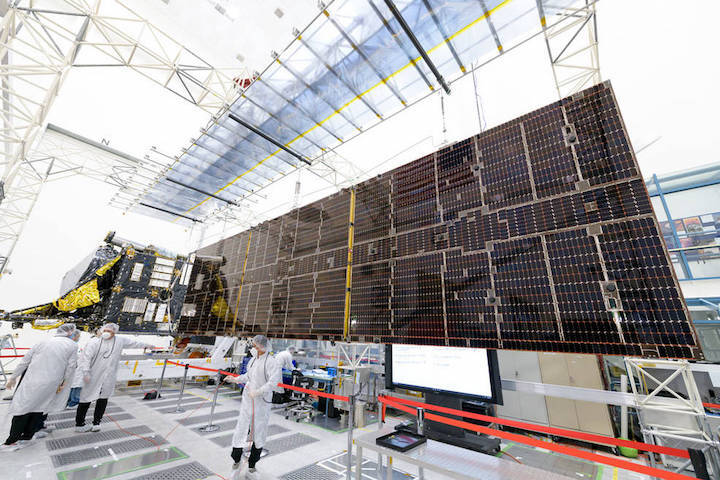
With its solar arrays installed, the spacecraft is close to its final configuration ahead of a planned August launch.
NASA’s Psyche mission is almost ready for its moment in the Sun – a 1.5-billion-mile (2.4-billion-kilometer) solar-powered journey to a mysterious, metal-rich asteroid of the same name. Twin solar arrays have been attached to the spacecraft body, unfolded lengthwise, and then restowed. This test brings the craft that much closer to completion before its August launch.
“Seeing the spacecraft fully assembled for the first time is a huge accomplishment; there’s a lot of pride,” said Brian Bone, who leads assembly, test, and launch operations for the mission at NASA’s Jet Propulsion Laboratory in Southern California. “This is the true fun part. You’re feeling it all come together. You feel the energy change and shift.”
At 800 square feet (75 square meters), the five-panel, cross-shaped solar arrays are the largest ever installed at JPL, which has built many spacecraft over the decades. When the arrays fully deploy in flight, the spacecraft will be about the size of a singles tennis court. After a 3 ½-year solar-powered cruise, the craft will arrive in 2026 at the asteroid Psyche, which is 173 miles (280 kilometers) at its widest point and thought to be unusually rich in metal. The spacecraft will spend nearly two years making increasingly close orbits of the asteroid to study it.
Venturing to the asteroid belt between Mars and Jupiter, far from the Sun, presents challenges for this mission, which adapted standard Earth-orbiting commercial satellite technology for use in the cold and dark of deep space. Near Earth, the solar arrays generate 21 kilowatts – enough electricity to power three or four average U.S. homes. But at Psyche, they’ll produce only about 2 kilowatts – sufficient for little more than a hair dryer.
The underlying technology isn’t much different from solar panels installed on a home, but Psyche’s are hyper-efficient, lightweight, radiation resistant, and able to provide more power with less sunlight, said Peter Lord, Psyche technical director at Maxar Technologies in Palo Alto, California, where the arrays and solar electric propulsion chassis were built. “These arrays are designed to work in low-light conditions, far away from the Sun,” he added.
After the successful installation and deployment of the three center panels inside a clean room at JPL, Psyche’s arrays were folded back against the chassis and stowed for additional spacecraft testing. The arrays will return to Maxar, which has specialized equipment to test the deployment of the two perpendicular cross panels. Later this spring, the arrays will be reunited with the spacecraft at NASA’s Kennedy Space Center in Florida and stowed for launch from Cape Canaveral.
About an hour after launch, the arrays will deploy and latch into place in a process that will take 7 ½ minutes per wing. They will then provide all the power for the journey to asteroid Psyche, as well as the power needed to operate the science instruments: a magnetometer to measure any magnetic field the asteroid may have, imagers to photograph and map its surface, and spectrometers to reveal the composition of that surface. The arrays also power the Deep Space Optical Communications technology demonstration that will test high-data-rate laser communications.
What those instruments relay to scientists will help them better understand the mysterious asteroid. One possible explanation for Psyche’s unusually high metal content is that it formed early in our solar system’s history, either as remnant core material from a planetesimal – one of the building blocks of rocky planets – or as primordial material that never melted. This mission aims to find out, and to help answer fundamental questions about Earth’s own metal core and the formation of our solar system.
Quelle: NASA
----
Update: 20.03.2022
.
Un-Earthing planetary defense: Studying extraterrestrial bodies could help defend Earth from future impact threats (op-ed)
Update: 25.05.2022
.
Launch of NASA’s Psyche asteroid mission delayed to late September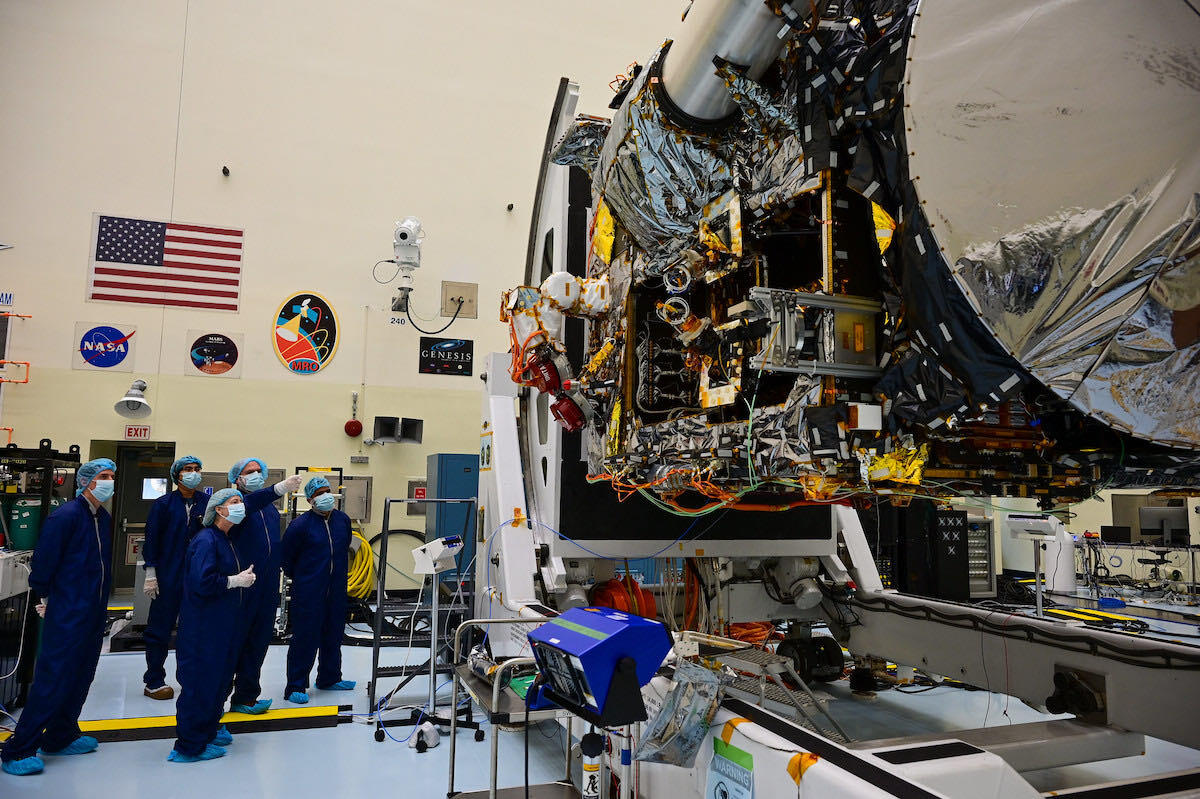
The launch of NASA’s Psyche asteroid mission, which was set for Aug. 1 on a SpaceX Falcon Heavy rocket, has been delayed to no earlier than Sept. 20 after ground teams discovered an issue during software testing on the spacecraft, officials said Monday.
The robotic asteroid explorer arrived at NASA’s Kennedy Space Center in Florida from the Jet Propulsion Laboratory in California on April 29 aboard a U.S. military cargo plane. Then ground teams moved the spacecraft, packed inside a climate-controlled shipping container, to a clean room at the Payload Hazardous Servicing Facility.
Technicians unboxed the Psyche spacecraft and moved it to a handling fixture for a series of hardware and software tests to make sure the probe survived the cross-country trip from California.
But a technical issue interrupted the test campaign, and will delay the launch of the Psyche mission at least seven weeks.
“An issue is preventing confirmation that the software controlling the spacecraft is functioning as planned,” NASA said in a written statement, responding to questions from Spaceflight Now. “The team is working to identify and correct the issue.”
The new launch readiness date for Psyche is no earlier than Sept. 20, according to Gretchen McCartney, a spokesperson at JPL, the NASA center leading the Psyche mission.
The mission has a launch period extending from Aug. 1 into the fall, when Earth is in the proper position in the solar system to make Psyche’s interplanetary journey feasible. The spacecraft is headed for the asteroid Psyche — the spacecraft’s namesake — a metal-rich world in the asteroid belt between the orbits of Mars and Jupiter.
NASA and members of the Psyche team did not respond to a question on the exact length of the mission’s interplanetary launch period this year, or when the mission’s next launch period would open after 2022.
Other work required to prepare the Psyche spacecraft for launch included the installation of its deep space transponder, part of the probe’s communications system, after it had to be removed from the spacecraft at JPL for troubleshooting. Ground crews also plan to load more than a ton of xenon gas into the spacecraft’s all-electric propulsion system, then encapsulate Psyche inside the nose cone of its launch vehicle.
A Falcon Heavy rocket provided by SpaceX will blast off from pad 39A at Kennedy and hurl the Psyche spacecraft on an escape trajectory away from Earth, allowing the probe to reach Mars in May 2023 for a flyby maneuver, using the planet’s gravity to slingshot toward its asteroid destination.
The Psyche spacecraft will reach the asteroid Psyche in January 2026, then enter a series of orbits at different distances to map the unexplored world. Psyche, the asteroid, has an irregular shape, an average diameter of about 140 miles (226 kilometers), and is made mostly of nickel and iron metals.
Psyche was assembled and tested at JPL. Maxar Technologies, a builder of commercial communications satellites, provided the spacecraft’s chassis, propulsion system, and solar panels. JPL, with extensive experience in deep space operations, provided Psyche’s flight computer, software, and parts of the communications and power systems.
The three-and-a-half year trip to asteroid Psyche will span 1.5 billion miles (2.4 billion kilometers). The spacecraft is designed to spend at least 21 months studying the asteroid after arrival in 2026.
NASA selected Psyche as a Discovery-class, cost-capped interplanetary mission in 2017, alongside the Lucy asteroid explorer, which launched last year. The Psyche mission’s total cost is nearly $1 billion, including development, launch services, and operations.
Two small spacecraft will hitch a ride to space with Psyche. NASA’s twin Janus probes, each weighing just 80 pounds (36 kilograms), will launch on the same Falcon Heavy rocket as Psyche, but will head off into the solar system to fly by separate asteroids.
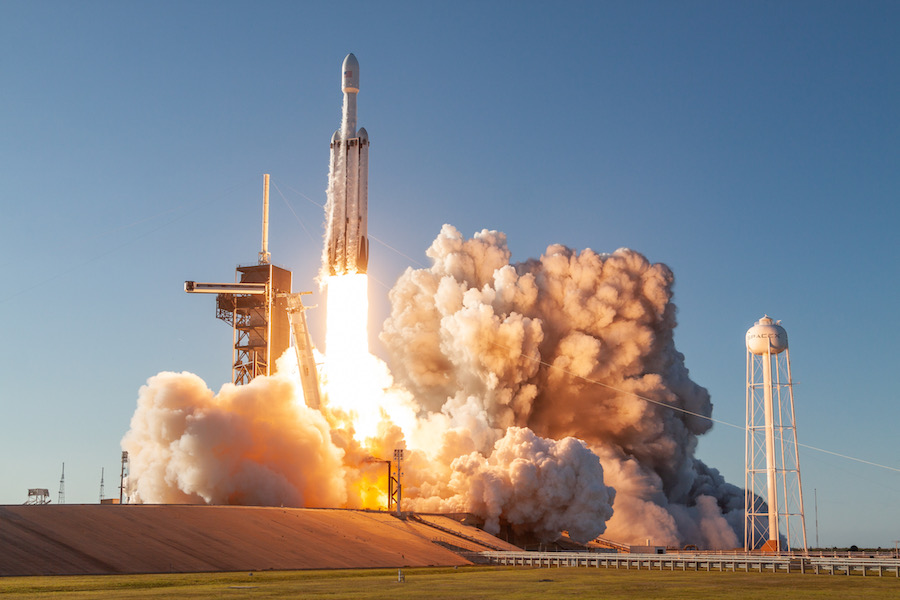
The Psyche mission will mark NASA’s first use of SpaceX’s Falcon Heavy rocket, a heavy-lifter created by connecting three SpaceX Falcon 9 rocket boosters together. The design gives the Falcon Heavy rocket 5.1 million pounds of ground-shaking thrust at liftoff, generated by 27 Merlin main engines.
SpaceX launched the first three Falcon Heavy missions in 2018 and 2019, but more than three years will have passed between the third and fourth Falcon Heavy rocket flights.
Several Falcon Heavy launches are potentially scheduled before the end of the year, including NASA’s Psyche mission and the commercial ViaSat 3 Americas broadband internet satellite, also slated to launch no earlier than the September timeframe.
The U.S. Space Force has two Falcon Heavy missions that could launch late this year with secret military satellites. One of those missions, USSF 44, had been tentatively scheduled for late June, but has been postponed indefinitely. A Space Force spokesperson said last week he could not provide an updated schedule for the USSF 44 mission.
Another Space Force launch, designated USSF 52, is also assigned to a Falcon Heavy launch. It was originally scheduled to fly after USSF 44 in the October timeframe, but that was before the latest delay in the USSF 44 mission.
All of the delays to the upcoming Falcon Heavy missions have been caused by payload issues.
The Space Force’s USSF 44 mission was supposed to launch in late 2020, and the Space Force has attributed the schedule slips to spacecraft delays.
Viasat’s next-generation broadband satellite, set to beam internet connectivity to the Americas, has faced manufacturing, workforce, and supplier problems the company has partly blamed on the COVID-19 pandemic. NASA’s Psyche asteroid mission is the latest Falcon Heavy payload to run into a launch delay. Quelle: SN
----
Update: 26.06.2022
.
NASA asteroid mission on hold due to late software delivery
NASA's plan to explore a strange metal asteroid is on hold
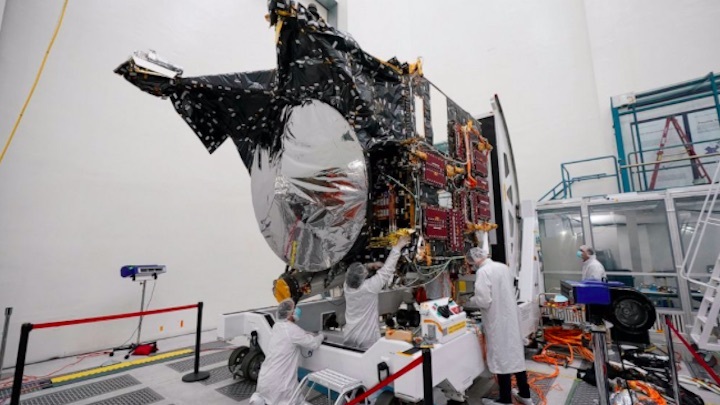
NASA put an asteroid mission on hold Friday, blaming the late delivery of its own navigation software.
The Psyche mission to a strange metal asteroid of the same name was supposed to launch this September or October. But the agency’s Jet Propulsion Lab was several months late delivering its software for navigation, guidance and control -- a crucial part of any spacecraft. Engineers “just ran out of time” to test it, officials said Friday.
Now the space agency is going to step back, and an independent review will look at what went wrong, when the spacecraft could launch again and even if it should go ahead, NASA planetary sciences chief Lori Glaze said.
NASA has already spent $717 million on Psyche and its projected total cost, including the rocket to launch it, is $985 million. The small car-sized spacecraft was originally supposed to arrive at its asteroid in 2026 after a journey of more than 1 billion miles.
Now that the software has been delivered, there’s no known problems with the spacecraft except “we just haven’t been able to test it,” said Lindy Elkins-Tanton, the Psyche mission lead scientist.
“There is that one challenge we couldn’t overcome in time to launch in 2022 with confidence,” she said.
There are still at least two launch opportunities next year and more in 2024 to get to the asteroid that sits in the belt between Mars and Jupiter, said JPL Director Laurie Leshin. That means Psyche wouldn’t arrive at its asteroid until 2029 or 2030.
But calculating launch times is complicated because the mission needs the proper sunlight conditions and the asteroid “is spinning like a rotisserie chicken instead of like a top,” Elkins-Tanton said.
Two other small missions were going to ride along on the SpaceX Falcon heavy rocket and NASA is looking at what will happen to those.
Psyche is just the latest in NASA's fleet of asteroid-exploring spacecrafts. Osiris-Rex is on the way back to Earth with rubble from the asteroid Bennu. Last year, NASA launched the ships Lucy and Dart to explore other space rocks and test if a rocket could knock off course an asteroid heading smack into Earth.
Quelle: abcNews


